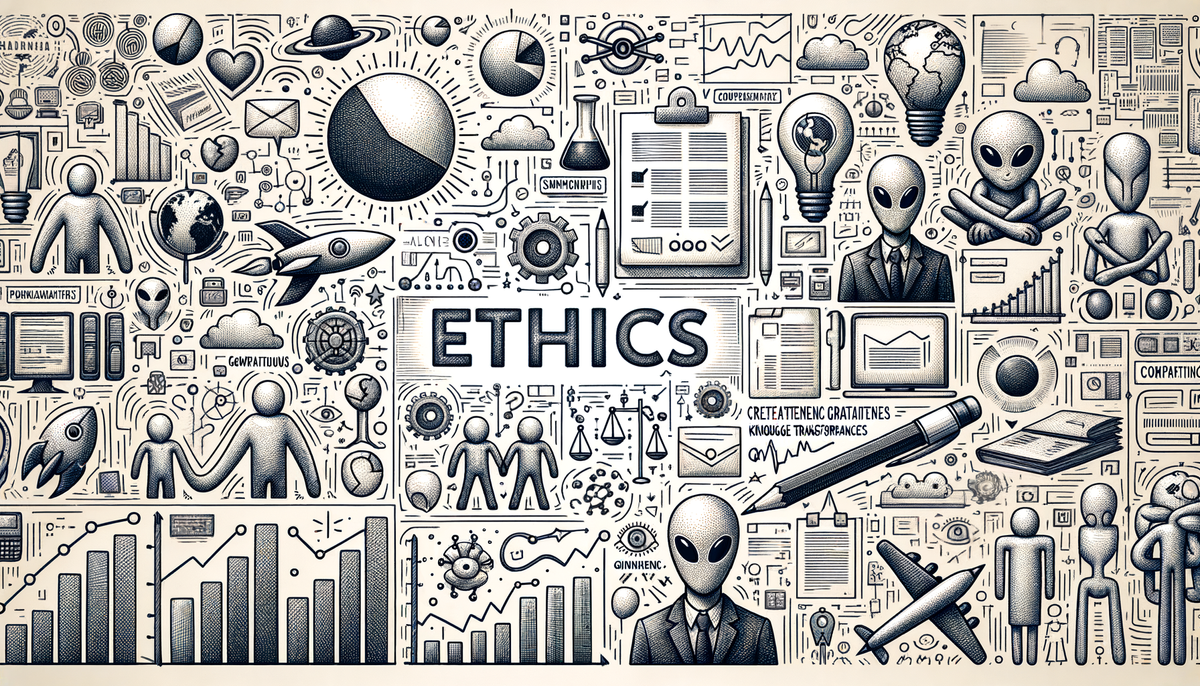AI Scraping and Its Implications: Insights and Challenges

AI scraping, talent battles, ethical guidelines, and transformative infrastructure updates are reshaping not only the technology landscape but also our understanding of work, creativity, and governance. This dynamic evolution is sparking debates about the balance between innovation and regulation, while also revealing surprising twists—from AI turning saved time into more work, to massive investments in talent that fuel the race towards superintelligent systems.
Scraping the Web: Opportunities, Challenges, and Future Directions
The concept of AI scraping has ignited debates in tech circles, with discussions centering on legality and the future of data ownership. According to The Wall Street Journal, the future of web scraping is not just about data extraction, but a broader conversation on the ethics and the structural integrity of the digital ecosystem.
This emerging debate touches on a number of concerns: from intellectual property rights to the competitive dynamics between tech giants. Some view scraping as a natural extension of the democratization of data access, while others caution against potential abuses that could compromise proprietary content and user trust. Over time, the interplay between regulation and innovation might lead to clearer guidelines, encouraging fair use without stifling creativity.
In many respects, AI scraping exemplifies the age-old battle between safeguarding creative output and enabling technological progress. The dialogue is reminiscent of historical debates over copyright in literature or music, but now amplified by the speed and scope of digital technologies. It leaves us pondering how much freedom should be allowed in the digital no-man’s-land.
Work Transformed: The Paradox of AI-Driven Efficiency
One of the most striking modern ironies is how AI, while designed to streamline tasks and create free time, often results in an overflow of additional work. A widely discussed feature from The Wall Street Journal reveals that instead of experiencing a reduction in workload, many professionals encounter an increase in tasks. The time they save using AI is often redirected to new, unforeseen responsibilities.
This phenomenon underscores a deeper cultural issue: the constant push for productivity and the belief that every bit of saved time needs to be utilized. For many organizations, the implementation of AI tools is less about reducing work and more about maximizing throughput and maintaining competitive advantage. In fact, this echoes the wise words of
Andrew Ng once said, "Artificial intelligence is the new electricity." The statement reminds us that, much like electricity, AI has the potential to transform industries—but such transformations are seldom without their inherent complexities.
As professionals navigate these paradoxical outcomes, it is helpful to discuss workplace adjustments with a critical eye. Platforms like AI Podcast by AI.Biz continuously explore these nuances, offering insights on how businesses can adapt while managing expectations in a rapidly changing environment.
Capital Flows and Talent Wars: Investing in the Future of AI
The investment landscape in AI has become a high-stakes game, where strategic decisions can significantly affect market trajectories. Prominent voices like Kevin O'Leary have recently voiced their reluctance to invest in companies that ignore the potential of AI. His assertion, featured on Cointelegraph, is a testament to the growing belief that AI is not merely an add-on feature—it is central to future success.
In a similarly bold move, Meta’s CEO Mark Zuckerberg has spent over $200 million to poach a top AI leader from Apple and strengthen Meta’s Superintelligence team. As reported by TechRepublic, this strategic hiring is designed to bring disruptive innovation into Meta's fold. Such massive investments underscore the fierce competition among tech behemoths, where talent is as valuable as technology itself.
These developments highlight a strategic pivot: while traditional business models once prized incremental improvements, the digital age prizes rapid advancements in machine learning and cognitive computing. This race for talent not only fuels further innovation but also shapes market dynamics in ways that ripple across startups and established companies alike. Whether you are an investor, an entrepreneur, or simply an enthusiast, these trends suggest that staying updated with AI developments is imperative.
Boosting the Infrastructure: AWS and the Evolution of SageMaker
The backbone of modern AI solutions lies in robust infrastructure, and Amazon Web Services (AWS) is stepping up its game through significant upgrades to its SageMaker platform. As detailed on VentureBeat, these enhancements improve observability, optimize GPU performance, and simplify the coding process, addressing some of the most pressing challenges in AI model development today.
One of the key innovations is the introduction of the HyperPod feature, which offers deep insights into various operational layers and subsequently reduces troubleshooting time from weeks to mere hours. This shift means developers can devote more time to creating innovative solutions rather than wrestling with infrastructure challenges. AWS’s approach even integrates local development environments, ensuring that developers can work within familiar tools while tapping into the scalable computational power of SageMaker.
The upgrades underscore a broader industry trend—shifting focus from flashy foundational models to nurturing a powerful, reliable infrastructure that supports the daily realities of AI projects. AWS’s strategy, while distinct from rivals like Google and Microsoft, reflects a commitment to empowering users—an approach that has boundless implications for enterprises seeking agility and efficiency in the face of ever-growing computational demands.
Design and Creativity: AI as a Tool for Amplifying Human Expression
While the conversation about AI is often dominated by metrics and performance, there is another side of the story that celebrates creativity. At TechCrunch Disrupt 2025, Runway co-founder Alejandro Matamala Ortiz emphasized the importance of merging AI with design principles to boost human creativity rather than replacing it. This session, as covered on TechCrunch, showcased innovative applications of generative AI in creative fields such as film and marketing.
Matamala Ortiz’s insights remind us that AI tools, when designed with a creative mindset, can serve as catalysts for artistic innovation. By emphasizing human-centric design, these tools can bridge the gap between automation and artistry, democratizing the creative process. This narrative ultimately reinforces the need for a balanced integration of technology in cultural and artistic domains.
For creative professionals wondering how AI can fit into their workflow, the message is clear: instead of fearing obsolescence, consider AI as an augmentative force—an ally that enhances artistic capability and unlocks new levels of expression. This perspective is discussed on other platforms too, including AI Innovations: Ethical Considerations Deep Dive, where the focus is also on responsible deployment and fostering environments where creativity thrives.
Ethical Compass and Regulatory Landscapes: Navigating the AI Future
As AI technologies integrate deeper into our daily lives and industries, ethical considerations and regulatory frameworks become critically important. The European Union has recently rolled out a voluntary AI Code of Practice, as featured in a Wall Street Journal article. This initiative aims to guide companies in developing AI responsibly and ethically—a crucial step in ensuring that the pace of technological innovation does not outstrip our social and moral frameworks.
Complementing these discussions, some experts warn of AI-triggered negative feedback loops in our social and psychological realms. For instance, a thought-provoking piece on Psychology Today explores how overreliance on AI-mediated interactions might lead to unintended consequences in behavior and cognition. While these concerns might seem daunting, they offer a roadmap for proactive measures—encouraging dialogue, research, and the continuous integration of safeguards in AI deployment.
Regardless of the sector—from creative endeavors to industrial applications—the need for ethical vigilance cannot be overstated. As
Fei-Fei Li aptly put it, "I imagine a world in which AI is going to make us work more productively, live longer, and have cleaner energy." Though not every aspect of AI evolution is positive at first glance, such a vision calls for an unwavering commitment to ethical progress. For more insights on how these ethical challenges are being tackled, you can check out the latest insights on our AI News Podcast Update.
Authenticity in the Age of AI: Differentiating Reality from Simulation
The ability of AI to generate convincing content has also raised concerns about authenticity. Technology platforms now grapple with the challenge of indicating whether a mesmerizing video in your feed is a product of human creativity or AI generation. An article in The Wall Street Journal highlights this very struggle. The blending of machine-generated content with authentic human experiences propels us into uncharted territory where trust, transparency, and digital literacy are paramount.
In this rapidly evolving digital milieu, users are encouraged to engage critically with content, discerning subtle cues that may indicate artificial origin. Such challenges open up avenues for innovation in verification tools and digital watermarking techniques—an area that promises to evolve as quickly as the technologies themselves.
Looking Ahead: A Future of Controlled Disruption and Boundless Possibilities
The multifaceted evolution of artificial intelligence invites us to reflect on both its boundless possibilities and the need for measured, ethical deployment. From scraping techniques that challenge data ownership laws to infrastructural innovations that streamline AI development, the journey is as intricate as it is exciting.
Whether you are a seasoned developer, a curious entrepreneur, or someone intrigued by the transformative power of technology, it is clear that AI is rewriting the rules of engagement across industries. As one insightful observation puts it,
Sherry Turkle noted, "AI is a reflection of the human mind—both its brilliance and its flaws." This encapsulates the dual nature of AI, urging us to celebrate its innovations while remaining vigilantly aware of its broader social implications.
The path forward will likely be one of controlled disruption—a dance between rapid technological advances and robust ethical safeguards. For those keen on exploring additional dives into these topics, our community updates such as Today AI Innovations & Challenges and AI Innovations: Ethical Considerations Deep Dive offer a continuous stream of insights and discussions.
It is an exhilarating time to witness the unfolding narrative of artificial intelligence—one that offers both awe-inspiring opportunities and thoughtful challenges that demand our collective ingenuity and ethical rigor.
Further Readings
- Today AI Innovations & Challenges
- AI Innovations: Ethical Considerations Deep Dive
- AI Podcast: Industry Insights and Innovations
- AI News Podcast Update: Transformative Advances & Ethical Considerations
Indeed, as we move forward in this era of rapid change, the interplay of innovation and responsibility continues to shape a future where every breakthrough is both a gift and a challenge for society.




